Liana actinidia is rarely found in the suburban areas of our country. The reason is high sensitivity to cold, because an exotic plant came to us from the southeastern regions of Asia, where the climate is much milder. Therefore, it is necessary to carefully prepare actinidia for winter frosts since the fall. In order for the liana to bloom again in spring, it needs to be trimmed and closed from frost.
Content
General tips for preparing actinidia for winter
The survival of actinidia in winter frosts in the Russian climate depends entirely on how faithfully care was carried out in the fall. To protect against characteristic diseases and prepare for colds, a number of mandatory measures are taken.
Watering and feeding
Actinidia refers to hygrophilous plants, therefore, for good growth, the soil is constantly kept moist. But you can not fill the vine. Stagnant moisture at the roots causes actinidia to die. Therefore, when planting vines in advance arrange a good drainage. Actinidia should be watered in autumn only if there is no rain for a long time. Then 60-80 liters of water are spent on one vine.
For autumn top dressing of exotic actinidia, fertilizers with a large proportion of phosphorus and potassium or organics are used. At the same time, they dig around the small bore circle to a shallow depth. For each square meter, 2 kg of rotted manure or 15 g of potassium salt and 50 g of superphosphate are enough. You can use ready-made multicomponent preparations that do not contain nitrogen and additionally add 2 buckets of compost each.
Autumn pruning
A haircut in the fall is performed taking into account the variety of creepers. For actinidia forming fruits only on branches of short length, the crown is trimmed more intensively to stimulate fruiting. Other varieties, in contrast, form berries on long lashes, so even a weak pruning reduces yield.
In the process of trimming, the structural features of actinidia are taken into account. The creeper has three types of shoots:
- vegetative, not involved in the formation of fruits;
- on vegetative-generative berries are formed only at the ends of branches;
- on the side shoots of a generative nature, the main crop is formed.
When pruning, in addition to determining the type of branch, take into account that the berries are tied only on annual branches.
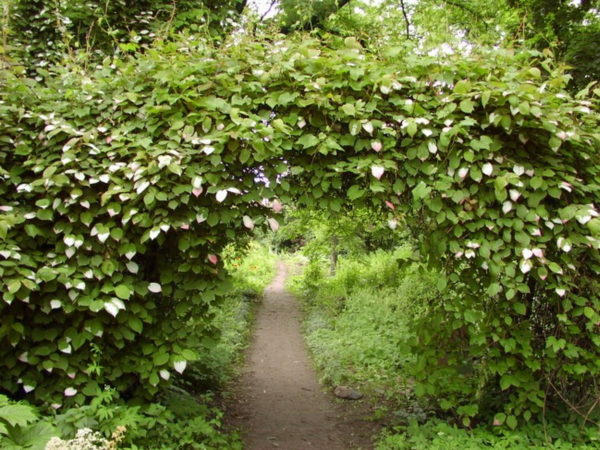
Need to trim
With the onset of autumn, knowledgeable gardeners begin pruning an exotic vine. Failure to follow this procedure causes problems with the development of the plant and reduces yield.
Trimming actinidia is needed to:
- the crown was not too thick;
- improve disease resistance;
- stimulate the growth of young shoots;
- improve productivity;
- give liana a more attractive look.
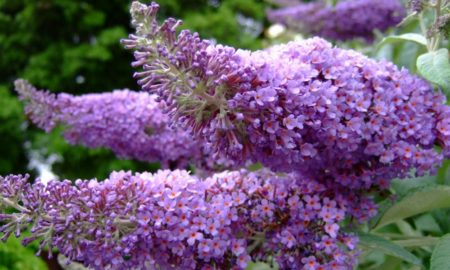 You may be interested in:
You may be interested in:Cropping time
Trimming actinidia is possible when there is no sap flow. The most suitable time for this procedure is late autumn, when the plant has already dropped foliage, or early spring, before the buds have swollen.If you tighten with pruning until April, when the sap flow begins, in the places of cuts there will remain unhealed wounds and the plant may die.
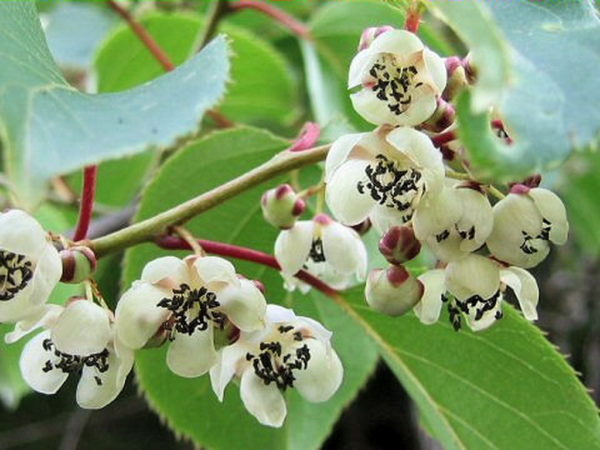
In autumn, pruning is performed after leaf fall is completed and constant minus temperatures are established at night. Usually this time falls on October or November depending on the climatic zone.
Correct Cutting Technology
Actinidia refers to fast-growing plants. Therefore, she needs regular pruning to prevent thickening of the crown. This procedure increases the immunity of the creeper against the disease and enhances survival in the winter cold.
Trimming actinidia in autumn is performed in the following order:
- All shoots with injuries, signs of illness or drying out are cut off, leaving two living buds.
- Branches bearing fruit for three years are also cut, replacing the younger ones. The age of the shoot in this case is determined by the shade of the bark.
- Vegetative branches are shortened to a length of 50 cm.
- Old shoots that do not give a large number of fruits are cut into a ring.
- In subsequent years, the crown is simply thinned out and damaged branches are removed.
With the correct implementation of this instruction, even beginners cope with trimming actinidia. As a result, the plant gives a good harvest and becomes decorative.
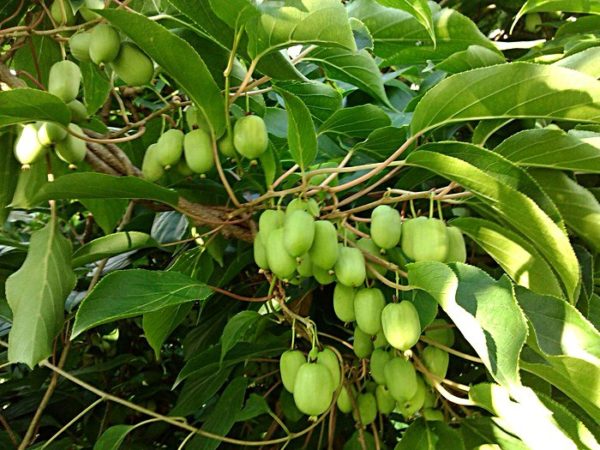
Care after trimming
After trimming the actinidia, all the fallen leaves along with the remains of the plant are raked from the site, removed and burned. There is no need to fertilize the vine at this time. After cleansing the territory, actinidia is prepared for closure for the winter.
Shelter for the winter
Most species of actinidia are thermophilic and do not tolerate winter cold. Therefore, in our country, Colomkite actinidia is often grown, able to withstand a temperature drop from -23 to -35 degrees without additional protection. The remaining varieties are less common and their cultivation in the conditions of the Russian winter is impossible without additional shelter.
Regardless of varietal affiliation, young vines are shelled, whose age is no more than 2-3 years. This is due to a close occurrence to the surface of the root system. In addition, the bark on the shoots of young plants is very thin and is not able to protect well from frost. Adult actinidia shelter as necessary, focusing on climatic conditions and the type of vine. To do this, mulch the soil and close the lower part of the trunk.
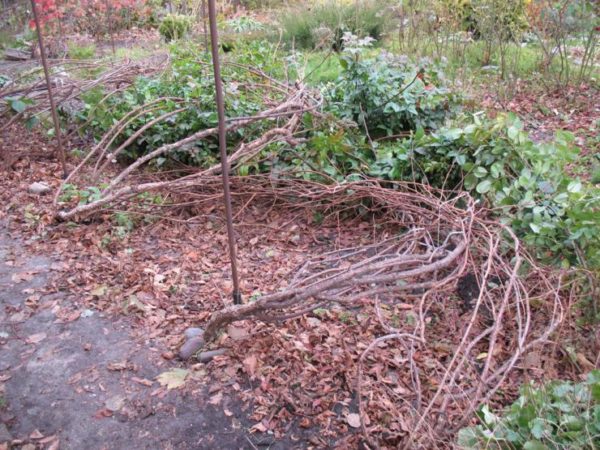
Material selection
For shelter use special agrofibre or suitable natural materials. In order to protect the shallow root system from the cold, the periostemal circle is necessarily mulched with suitable organic material: fallen leaves, straw, coniferous spruce branches or sawdust. For greater efficiency, it is recommended to combine several types of shelter. For example, they cover the soil with straw or sawdust, and coniferous spruce branches are fixed on top, which protects the natural material from blowing during strong winds and traps snow.
Nonwovens of industrial production have recently been used. Due to their properties and convenience, they quickly gained popularity:
- they do not change their properties under the influence of temperature fluctuations and precipitation;
- they pass air and moisture well;
- do not decay and are not covered by mold;
- resistant to mechanical abrasion;
- durable.
Shelter Order
Work on warming vines begins after the end of fall foliage and the establishment of cold weather. At first, they cover the roots of mulch. For this, in a small circle with a radius of 50 cm, the earth is mulched with a suitable natural material. Then the liana is untied from the support, folded into a neat bundle and laid around the trunk.To save actinidia from the invasion of rodents, poison from mice or bundles of dried dog mint are laid around it. Then the vine is completely covered with sawdust or fallen leaves and covered with coniferous spruce branches.
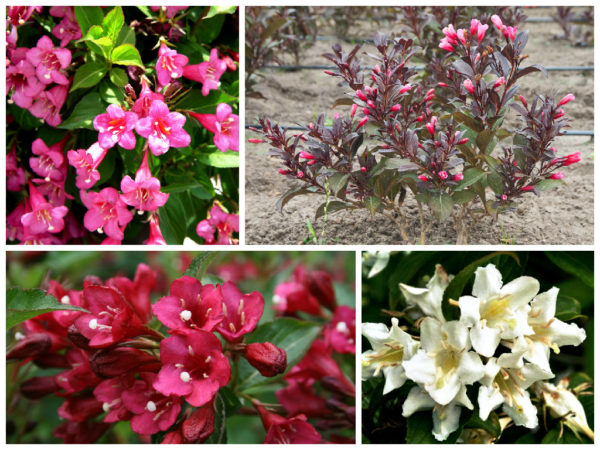 You may be interested in:
You may be interested in:To protect against severe frosts, agricultural fiber is additionally used. They several times wrap the liana collected in a bunch and only then lay the mulch and lapnik. Adult actinidia varieties that need warming for the winter are partially closed. To do this, mulch the earth and fill the trunk with natural material to a height of 20 cm, lay the spruce branches on top.
Finally, the shelter is removed in April. But if in the region often there are return frosts, the plant is wrapped in spandbond or lutrasil to protect it from freezing.
Preparing for winter in different regions
Weather in winter in different regions of Russia is different. This must be taken into account when closing adult vines for the winter. In the Moscow region and in the middle lane, winter-hardy anemone colomkit for winter can not be closed. For the other varieties, shelter from mulch is arranged, and coniferous branches are fixed on top.
In the Volga region, a vine is laid on a prepared pillow made of mulch. Sawdust or fallen foliage is poured on top and covered with agrofibre or roofing material. To protect against mice and other rodents, poison is laid nearby.
In the harsh Siberian climate and in the Urals, all varieties of actinidia are completely closed for the winter. To do this, the liana collected in a bunch is placed on a layer of mulch and covered with old rags or rags. Put polyethylene on top and pour a layer of soil 20 cm thick.
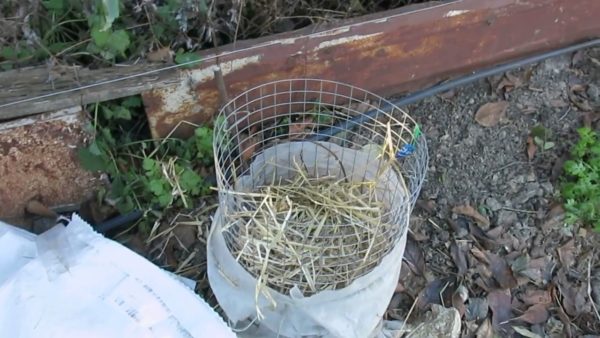
Possible mistakes
Gardeners do not always carry out the preparatory work correctly. This leads to damage or death of the vines. The main errors are:
- Perform autumn pruning according to one pattern for all varieties. This leads to a deterioration in productivity or a complete absence of fruits. The plant stops growth or completely dies.
- Too early closure of the liana, as well as late completion of work, causes the death of the plant.
- Carrying out pruning during sap flow leads to the fact that the damage does not last for a long time and the liana dies.
Conclusion
In time and correctly carried out pruning and sheltering actinidia for the winter, the vines remain viable until the next season. As a result, the plant will adorn the garden all summer and will produce abundant fruits.

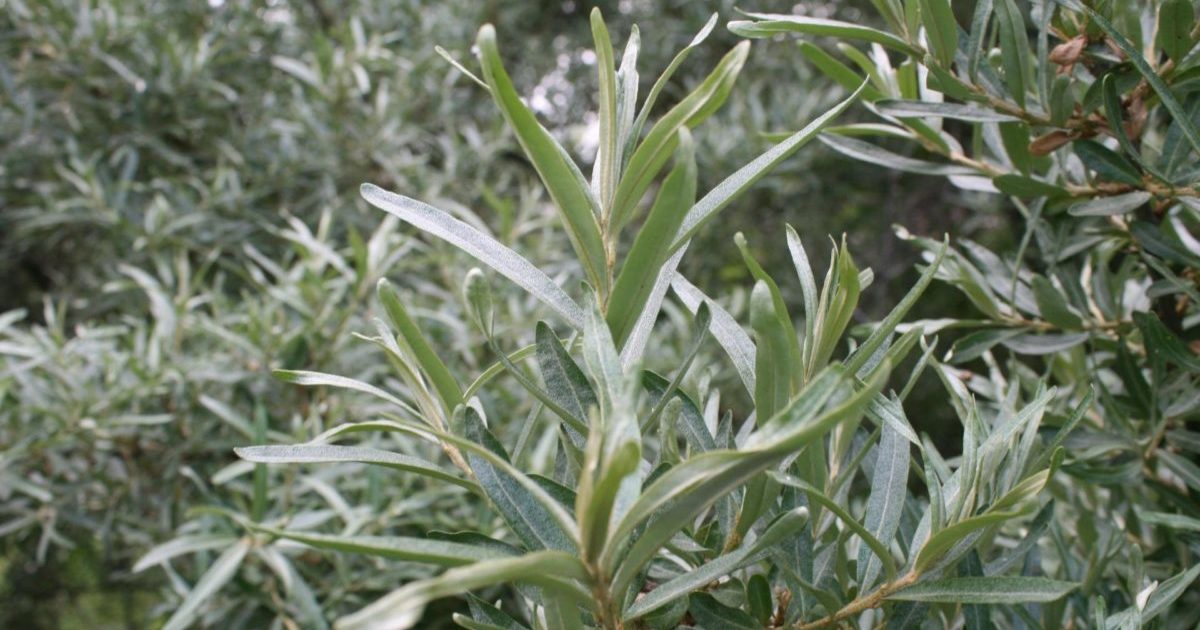 Sea buckthorn leaves - medicinal properties and contraindications, method of use and what can you drink from?
Sea buckthorn leaves - medicinal properties and contraindications, method of use and what can you drink from?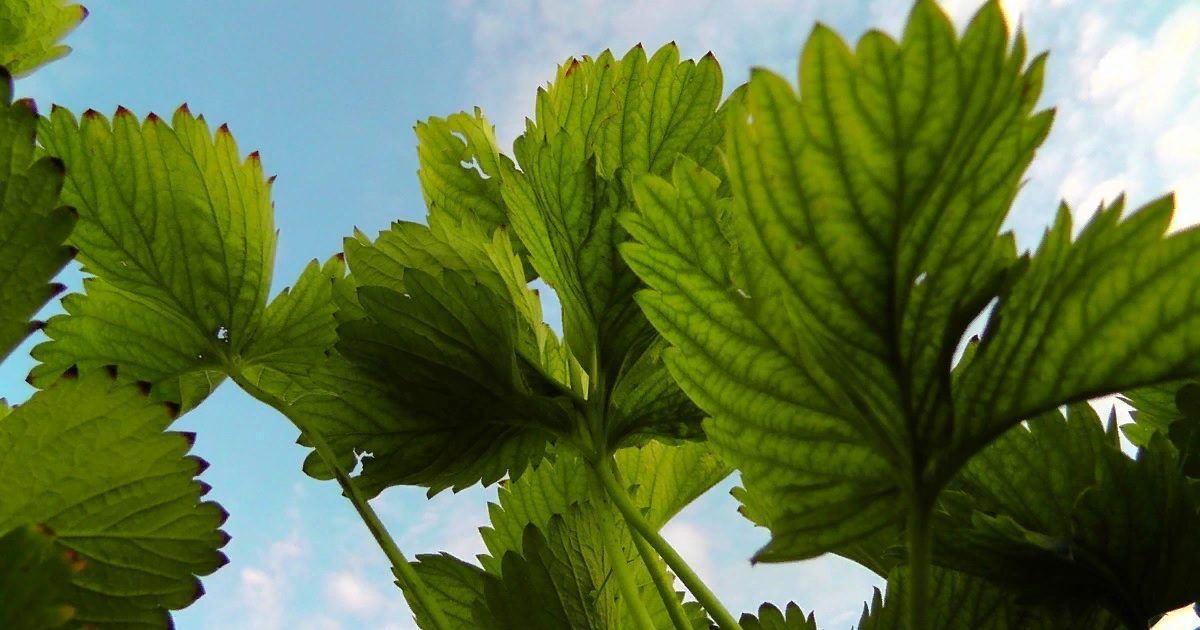 Strawberry leaves - medicinal properties and contraindications, benefits and harms
Strawberry leaves - medicinal properties and contraindications, benefits and harms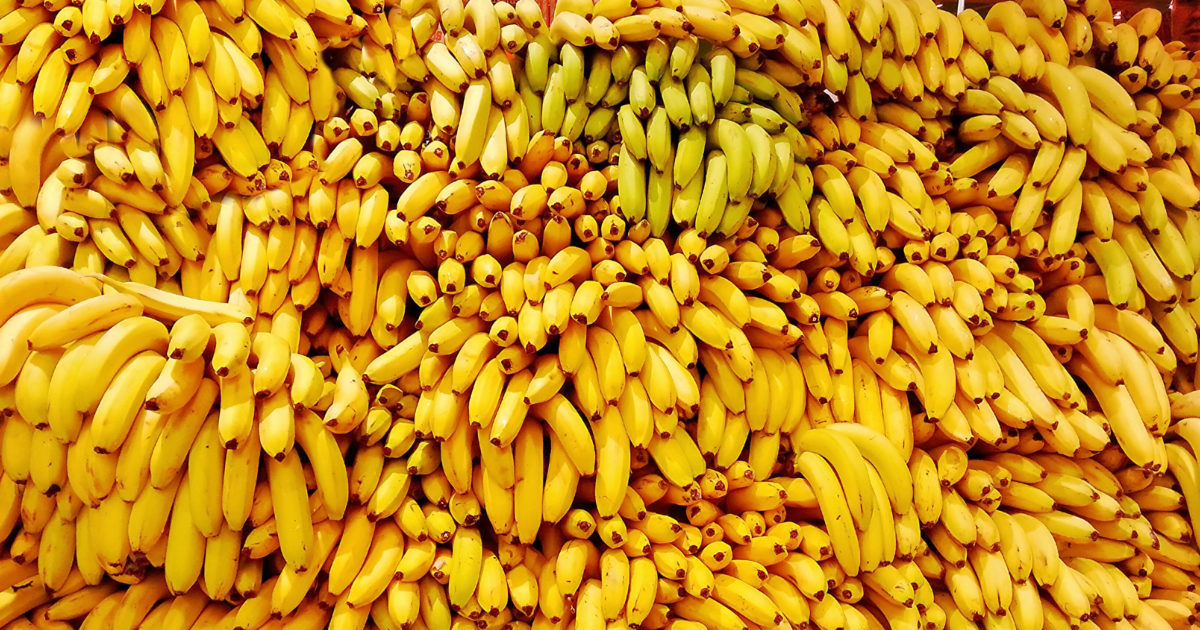 Banana - health benefits and harms, properties and contraindications
Banana - health benefits and harms, properties and contraindications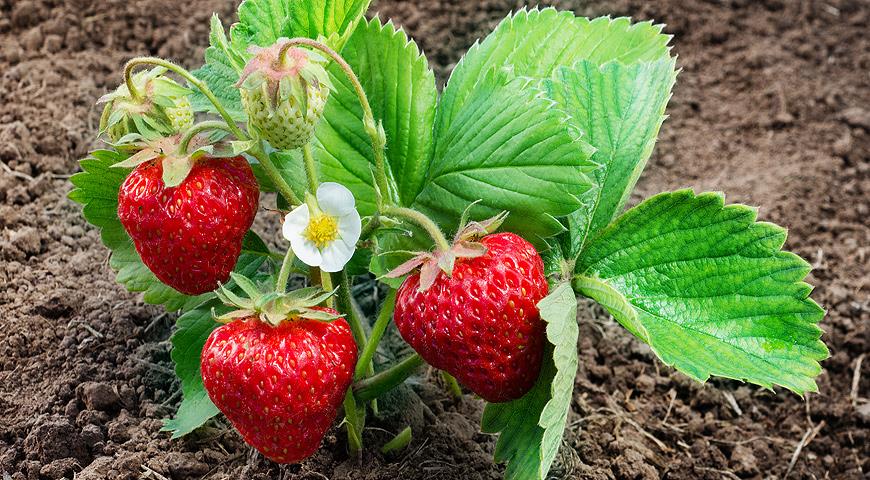 Wild strawberries! How to choose the perfect variety and grow it right?
Wild strawberries! How to choose the perfect variety and grow it right?